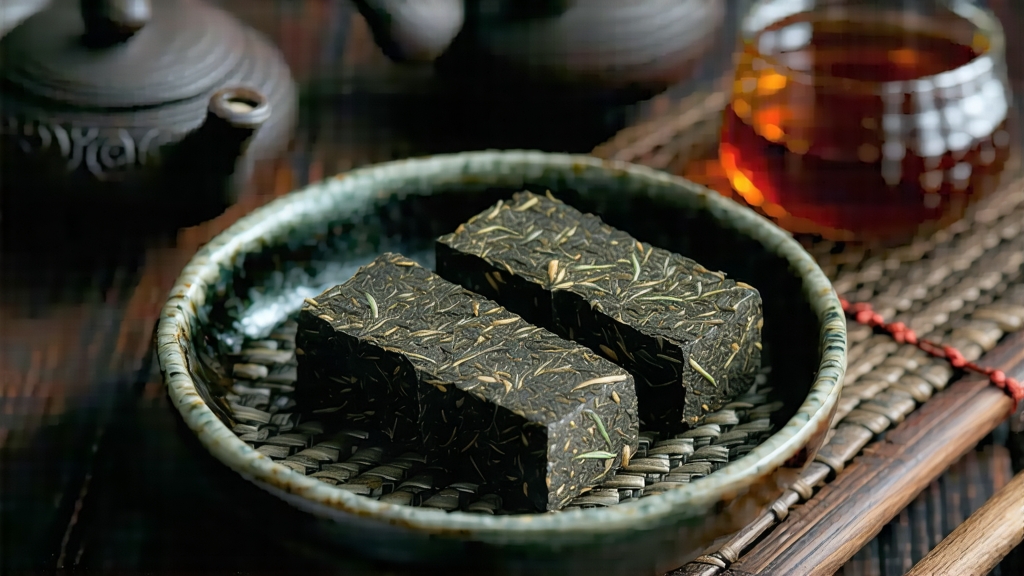
Tucked beneath the humid emerald canopies of southern Guangxi, Liupu tea waits like a quiet archive of centuries. Foreign palates often meet China’s dark teas through the smoky swagger of Anhua Fu bricks or the mellow heft of Yunnan Pu-erh, yet Liupu—older than many legends—remains an insider’s secret. This article invites the global tea traveler to discover why locals call it “the tea that remembers,” guiding you from Tang-dynasty horse caravans to your own gaiwan, and revealing how a humble leaf becomes a mellow, camphor-kissed elixir capable of aging longer than most wines.
-
Historical footpaths
Caravans departing the ancient port of Wuzhou in 836 CE carried silk, spices, and pressed tea leaves through the misty Da-yao mountains toward Southeast Asia. Imperial tax records list “Cangwu dark tablets,” the earliest name for what would later be stamped “Liupu,” after the county where trading boats moored. Because Guangxi’s climate is hotter and wetter than Yunnan, the tea fermented en route, arriving at its destination already dark, smooth, and unexpectedly sweet. Monks in Luang Prabang and merchants in Malacca adopted it as medicine for “damp stomachs,” spreading Liupu’s fame from cliff-side temples to the street bazaars of the Maritime Silk Road. By late Ming, Liupu bricks served as border currency; Qing soldiers were partially paid with them, and caravanners joked that a single brick could buy a horse in Lhasa or a wife in Kunming. The 20th century’s wars disrupted trade, but small family workshops kept micro-fermenting batches in earthen jars, preserving both microbes and memory. When China reopened, Liupu re-emerged, carrying antique flavors that no lab could synthesize. -
Terroir and leaf pedigree
Guangxi’s karst peaks trap monsoon clouds, bathing tea gardens in perpetual fog. The province’s native large-leaf variety, Camellia sinensis var. sinensis f. macrophylla, differs from Yunnan’s assamica: leaves are broader yet thinner, with a higher ratio of stem to blade. These stems act as wicks during fermentation, conducting oxygen and moisture that nurture golden spores of Eurotium cristatum—yes, the same “golden flower” prized in Hunan Fu bricks, but here they bloom smaller and denser, scenting the leaf with a faint betel-nut aroma. Soils are lateritic, rich in iron oxide and potassium, giving Liupu its trademark rusty-red infusion and mineral finish. Gardens sit between 300–600 m, elevations low enough for subtropical bacteria yet high enough for nightly mountain coolness, a thermal swing that concentrates amino acids and sugars. -
Crafting the darkness
Liupu production follows five seasons: bud-picking in Qingming, primary sun-withering, indoor pile-fermentation, steam compression, and cave aging. Yet the heart is the “wet pile” (dui-zi), a microbial choreography perfected over 400 years. After plucking one bud plus three leaves, workers sun-wither for three hours, then wok-fry at 180 °C for ninety seconds—just long enough to kill green enzymes while preserving leaf elasticity. The half-dry leaves are piled 70 cm deep on bamboo mats and misted with mountain spring water until moisture reaches 38 %. Covered by hemp canvas, the pile hovers around 55 °C for ten days. Masters turn the heap every 24 hours, sniffing for the moment grassy notes collapse into fermented soy, then into damp jujube. When the core temperature threatens 62 °C—dangerous for beneficial microbes—they break the pile, cool, and rest. Next comes compression: leaves are steamed for eight seconds, poured into cedar-lined wooden molds, and pressed under 20-ton stones for one hour, yielding dense 1 kg bricks stamped with the camellia crest of Wuzhou. Finally, bricks are moved to natural limestone caves where relative humidity stays 80 % year-round. There they hibernate for a minimum of three years, though connoisseurs seek the 1998 or 1983 vintages whose wrappers bear the ochre bloom of age. -
Variations within the dark
Although all Liupu is dark tea, micro-climates and minor tweaks create three recognized styles. “Cave Classic” (dong-cang) ages inside karst caverns, acquiring a petrich